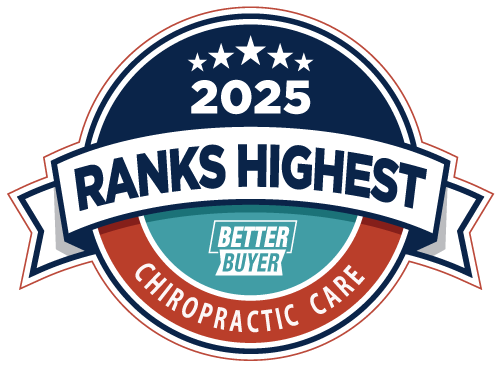2025 Chiropractic Care Satisfaction Study
Chiropractic Franchises Outperform Local, Independent Providers in All Areas of Patient Satisfaction Except Courtesy, Better Buyer Finds
AlignLife Ranks Highest in Overall Chiropractic Care Satisfaction
CHICAGO: 16 Feb. 2025 — While franchises may excel in structured and scalable systems, local independents leverage personalized care to achieve higher scores in certain satisfaction metrics, including courtesy of front desk staff, according to the Better Buyer 2025 U.S. Chiropractic Care Satisfaction Study℠ released today.
Local independent chiropractors outperform franchises in courtesy of front desk staff, with a weighted average satisfaction score of 4.37, surpassing all franchise providers. This suggests personalized, consistent interactions in smaller, independent practices leave a stronger positive impression on patients compared to the often standardized service experiences in franchises.

The study provides a comprehensive view of patient experiences across various chiropractic providers. The standout is AlignLife, achieving the highest overall satisfaction rating, with 50% of respondents marking their experience as "Very Satisfied" and 100% willing to recommend the provider. This combination underscores AlignLife's exceptional ability to meet patient expectations and foster unwavering loyalty among its clientele. AlignLife also received the highest percentage of "Very Satisfied" responses when respondents were asked about the effectiveness of the treatment received.
"This study highlights critical factors that contribute to patient satisfaction, such as courteous staff interactions, effective treatment, and a clean, comfortable clinic environment," said Matt Scroggs, head of research at Better Buyer. "Digital marketing efforts—search engine optimization and social media—emerged as essential tools for patient acquisition while the significance of personal referrals underscores the value of maintaining strong relationships with current patients."
About Better Buyer
Backed by real consumer feedback, Better Buyer's ratings, reviews, studies, and videos help people make better purchasing decisions while highlighting companies striving to provide customer service excellence.
2025 U.S. Chiropractic Care Satisfaction Study
The Better Buyer 2025 U.S. Chiropractic Care Satisfaction Study offers an in-depth analysis of patient satisfaction levels across various chiropractic providers. Based on a national survey, this report evaluates critical aspects of patient experience, ranging from appointment scheduling to the effectiveness of treatments. By identifying trends and areas for improvement, this study provides actionable insights for chiropractic franchise executives and independent practitioners to enhance their services and foster business growth. The following sections analyze survey responses, highlighting patient satisfaction percentages to determine strengths and opportunities for improvement.
Satisfaction with Aspects of Visit
Ease of scheduling an appointment: Satisfaction levels indicate moderate room for improvement. While 38.89% of respondents were very satisfied and 30.86% were somewhat satisfied, a combined 15.43% expressed dissatisfaction (8.02% very dissatisfied, 7.41% somewhat dissatisfied). Efforts to streamline appointment scheduling could enhance overall satisfaction.
Wait time before seeing the chiropractor: Patient satisfaction is relatively high, with 38.27% very satisfied and 29.01% somewhat satisfied. However, 13.58% expressed dissatisfaction (3.70% very dissatisfied, 9.88% somewhat dissatisfied), indicating that reducing wait times could improve the patient experience.
Courtesy of front desk staff: This aspect received the highest weighted average (4.17), with half of respondents very satisfied and 27.78% somewhat satisfied. Dissatisfaction was minimal at 6.79%, reflecting strong performance in front desk interactions.
Satisfaction with Environment
Cleanliness of the facility: This aspect scored highly, with 51.85% of respondents very satisfied and 22.22% somewhat satisfied. Dissatisfaction was minimal at 9.88%, reflecting a well-maintained clinic environment across all providers.
Comfort of treatment rooms: Similarly, this aspect performed well, with 48.77% very satisfied and 26.54% somewhat satisfied. With only 8.64% dissatisfaction, comfort appears to be a strong point for clinics.
Ease of Scheduling Appointment
Wait Time Before Seeing the Chiropractor
Satisfaction with Care Provided
Time spent by the chiropractor: Responses show favorable satisfaction, with 37.65% very satisfied and 33.33% somewhat satisfied. Still, 11.11% expressed dissatisfaction, suggesting a need to ensure adequate time allocation per patient.
Chiropractor’s ability to explain condition/treatment: This aspect received a weighted average of 4.12, with 48.77% very satisfied and 27.16% somewhat satisfied. Only 9.26% expressed dissatisfaction, indicating that clear communication is a strength nationally.
Effectiveness of treatment: Satisfaction levels are high, with 33.33% very satisfied and 36.42% somewhat satisfied. However, dissatisfaction at 11.73% (6.79% very dissatisfied, 4.94% somewhat dissatisfied) suggests that improvements in treatment outcomes could benefit patient perceptions and advocacy.
Effectiveness of Treatment Received
Overall Satisfaction with Chiropractic Experience
Industry Average Overall Satisfaction: Overall satisfaction is notably high, with 42.59% of respondents very satisfied and 30.86% somewhat satisfied. While only 10.49% expressed dissatisfaction, 16.05% of respondents were neutral, indicating some variability in experiences that could be addressed.
Likelihood of Recommending Provider: A substantial majority (82.10%) indicated they would recommend their provider to others, reflecting a high level of overall satisfaction and loyalty. However, the 17.90% who would not recommend their provider underscores the importance of addressing areas of dissatisfaction to maintain and grow patient advocacy.
Barriers to Seeking Chiropractic Care
For individuals who have not received chiropractic care, the survey identifies several key barriers:
- Uncertainty about effectiveness: The most significant barrier, cited by 38.57% of respondents, highlights a need for better education and outreach regarding the benefits and outcomes of chiropractic care.
- Lack of perceived need: 34.29% of respondents reported no health issues requiring chiropractic care. This indicates a gap in awareness of the potential preventive and holistic benefits of chiropractic treatment.
- Safety concerns: Safety apprehensions were expressed by 32.86% of respondents. Addressing misconceptions and providing evidence-based safety assurances could help alleviate these concerns.
- Lack of knowledge about chiropractic care: 28.57% of respondents indicated insufficient understanding of what chiropractic care involves. Educational initiatives could effectively address this barrier.
- Cost and insurance coverage: 22.86% of respondents found chiropractic care too expensive or not covered by insurance. Exploring more affordable care models or enhancing insurance partnerships may reduce this barrier.
- Preference for alternative treatments: 22.86% of respondents preferred other forms of treatment, such as physical therapy or medication. Highlighting complementary aspects of chiropractic care could shift these perceptions.
- Time constraints: 8.57% of respondents cited a lack of time to schedule appointments. Flexible scheduling and convenient options may help overcome this challenge.
- Limited clinic access: Only 4.29% reported a lack of conveniently located clinics, suggesting minimal geographic accessibility issues.
These insights underline the importance of targeted communication and accessibility improvements to address potential patients' concerns and encourage wider adoption of chiropractic care.
Barriers to Seeking Chiropractic Care
How Patients Learn About Chiropractors
The survey highlights various channels through which patients initially learn about chiropractic services:
- Recommendation from friends or family: This is the most common method, cited by 50.62% of respondents. Personal recommendations remain a powerful tool for attracting new patients.
- Organic search engine results: 23.46% of respondents discovered their chiropractor through unpaid search engine results, underscoring the importance of a strong online presence leveraging search engine optimization (SEO).
- Social media (organic): 17.28% of respondents learned about their chiropractor through organic social media posts, highlighting the value of an engaging and informative social media strategy.
- Paid search engine results: 14.81% of respondents were influenced by paid online advertisements, suggesting that investment in targeted advertising can be effective.
- Online reviews or ratings: 13.58% of respondents relied on platforms like Yelp, Angi, or Google Reviews. Maintaining positive online reviews is crucial for building trust and credibility.
- Walk-ins: 11.73% of respondents discovered their chiropractor by walking past or noticing the clinic. This indicates the importance of visible and appealing signage.
- Paid social media ads: Only 8.02% of respondents were influenced by sponsored posts or ads, suggesting that while helpful, this may not be the primary channel for patient acquisition.
- Other methods: 12.35% of respondents cited other unspecified ways they learned about their chiropractor, indicating some variation in outreach effectiveness.
How Patients Learn About Chiropractors
The analysis highlights the critical importance of digital marketing efforts, including online reviews, search engine visibility, and social media presence, in influencing appointment decisions. While personal referrals and affordability remain significant factors, the data underscores the value of a comprehensive digital strategy to attract new patients and reinforce trust. Providers should focus on enhancing their online reputation, optimizing website performance for search, and leveraging targeted online advertising to complement traditional referral networks and drive growth.
Closing Summary
The 2025 U.S. Chiropractic Care Satisfaction Study provides a comprehensive view of patient experiences across various chiropractic providers. The standout findings include AlignLife achieving the highest overall satisfaction rating, with 50% of respondents marking their experience as "Very Satisfied" and 100% willing to recommend the provider.
This study highlights critical factors that contribute to patient satisfaction, such as courteous staff interactions, effective treatment, and a clean, comfortable clinic environment. Digital marketing efforts emerged as essential tools for patient acquisition. Furthermore, the significance of personal referrals underscores the value of maintaining strong relationships with current patients.
To remain competitive, providers should focus on addressing operational inefficiencies, enhancing communication about treatment benefits, and ensuring high standards of care. By leveraging these insights, the chiropractic industry can continue to grow and deliver exceptional patient experiences.
Demographic Breakdown: Participants were distributed across four age groups. Respondents aged 18-29 comprised 15.09% of the sample, while 30-44-year-olds accounted for the largest group at 32.33%. Individuals aged 45-60 represented 29.74%, and those over 60 made up 22.84%. The sample included a higher proportion of female respondents at 60.78%, with male participants comprising 39.22%. The geographic distribution of respondents spanned nine major U.S. regions. The South Atlantic had the highest representation at 20.44%, followed by the Pacific region at 18.22%. Other notable regions included the East North Central (14.22%) and West South Central (14.67%). The Middle Atlantic accounted for 11.11%, while East South Central represented 8.89%. Smaller proportions were seen in the Mountain region (5.78%), West North Central (4.00%), and New England (2.67%).
About Better Buyer: Backed by real consumer feedback, Better Buyer's ratings, reviews, studies, and videos help people make better purchasing decisions while highlighting companies striving to provide customer service excellence. Better Buyer is a division of RivalMind, LLC.
Advertising/Promotional Rules: Charts and graphs extracted from this study for use by the media must be accompanied by a statement identifying Better Buyer as the publisher and the study from which it originated as the source. Rankings are based on numerical scores, and not necessarily on statistical significance. No advertising or other promotional use can be made of the information in Better Buyer press releases or survey results without the express prior written consent of Better Buyer. The Better Buyer Brand Humanity Index℠ awards are based on independent national consumer perception surveys conducted by Better Buyer. Award titles, names, and logos are proprietary to Better Buyer and may not be used for commercial purposes without a licensing agreement. Companies recognized in this study may reference their recognition in editorial/news contexts; however, any use of the award name, title, or logo in advertising, marketing, promotional, or sales materials requires prior written authorization and an active licensing agreement with Better Buyer.


